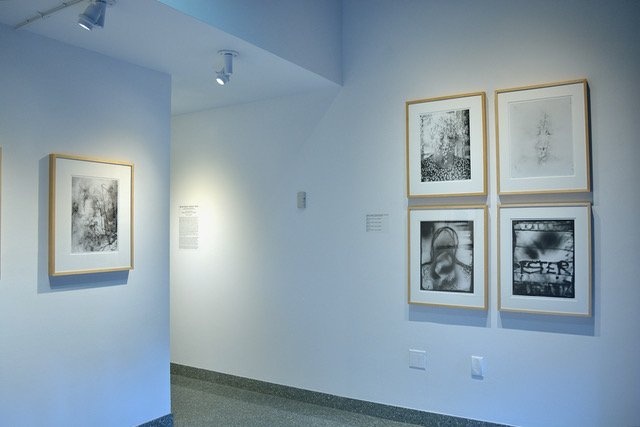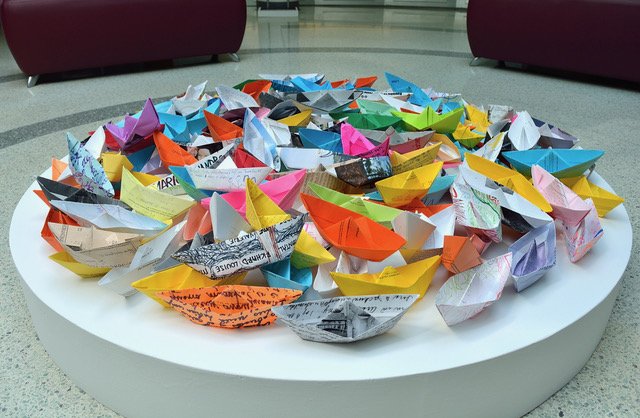Lost and Found: Unearthing the Echoes of Muriel Hasbun’s Seismic Traces
Migration, forced dislocation, and issues of diaspora are no strange concepts to Latinx communities in the United States. Through the lenses of loss, reclamation, and preservation, Muriel Hasbun’s current exhibition, Muriel Hasbun: Seismic Traces, speaks to these broad histories to connect her imagery and her viewership on an intimate level. Her sense of self as a Central American migrant exiled to the United States by the Salvadoran civil war, permeates the work and makes her personal diasporic experience palpable to the viewer. Her photographs and installations give her viewers a sense of both personal and collective memory, exile, and generational traumas.
Often considering themes of identity and migration, Hasbun’s artmaking practice mediates a complex crossover of language, interwoven diasporas, and histories of dispossession through such humanitarian horrors as the Holocaust and the Salvadoran civil war. Featuring works from as early as 1991 to more recent endeavors from 2020 and 2021, Seismic Traces presents a selection of some of Hasbun’s most powerful photographs, along with an interactive installation called barquitos de papel. Through various series represented in the exhibition, Pulse: New Cultural Registers / Pulso: Nuevos registros culturales, Santos y sombras / Saints and Shadows, and si je meurs / if I die, Hasbun unearths both silenced voices and those once forgotten, bringing them back to life and into the gallery through her photography and installation work.
Hasbun’s own familial history is rife with multiple exiles, diasporas, and traumas. Born in El Salvador to a Palestinian father and French Jewish mother whose family was decimated during the Holocaust, Hasbun’s formative years were spent in a diasporic space where her family and community were seen largely as foreign. Coming from both maternal and paternal histories of exile, Hasbun’s sense of identity was further transformed when the Salvadoran civil war forced her to migrate to the United States, once more interweaving a new diasporic experience onto the one her family already inhabited in El Salvador.
One of the two smaller wings at the front of the galleries highlights a series of Hasbun’s most recent works, Pulse: New Cultural Registers / Pulso: Nuevos registros culturales. This series, partially completed while in residence at Rutgers as the 2021-22 Estelle Lebowitz Endowed Visiting Artist, unearths histories of Galería el laberinto, the gallery founded by her mother which helped preserve and promote Salvadoran cultural legacies during the civil war of the ‘80s and ‘90s. The works combine the seismographic records of El Salvador with Hasbun’s personal visual archive, resulting in layered images that often deny pictorial space and complicate the ability to make out discernible objects. Pulse: Seismic Register 2020.02.28.035 (Aparición: Mother and Child, 1983), 2020, leaves me reaching desperately for a sense of the figures of mother and child, and yet every time I attempt to locate them, I am denied a full visual understanding, leaving me with the dull ache of frustration and strangely, loss. Faces appear and disappear in rapid succession, never fully forming in the hazily abstracted foreground. Another work in the series, Pulse: Seismic Register 2020.02.28.063, features angrily sweeping seismic records that appear almost as scratches or claw marks on the printed surface, leaving me to wonder about the way we are able or unable to read them. What was the event that caused these marks? Was it dangerous? Did it cause damage or human loss? The beauty of the richly layered images overshadows the potential in such seemingly simple lines to be indicative of intense destruction and overwhelming danger.
I was deeply drawn to the series of images called “Santos y sombras / Saints and Shadows,” 1991-2004. Four in particular—Ester IV, Ester II, Ester I, and Ester—make visible not only the ephemerality of photography as a medium, but also a deep sense of loss, and the imperceptible fading of one’s own memory. Hasbun’s keen ability to play with exposure and layered imagery creates soft, muted visuals that simultaneously highlight the portrait and obscure it. The photos are just as striking conceptually as they are visually, as Ester’s portraits hold weight beyond rote memorialization alone. For many years, Hasbun’s maternal grandfather thought he was the only family member to survive the Holocaust. In the 1970’s he discovered that his cousin, Ester, had also survived, though it took Hasbun many years more to discover the existence of Ester for herself. In photographing Ester, Hasbun resurrects an ancestral link previously thought to be lost and refuses the continued silencing of her history.
The Ester images are notably the only images in the exhibition to be stacked together, one on top of another in a two-by-two grid. Somehow, the grid makes them feel all the more immersive. The repetitions become clearer than when seen individually and the handwritten text—an address label—of Ester in the lower right-hand quadrant feels like its own gallery label or alternative name tag. Somehow, I feel like I know Ester. Her presence is palpable when you stand in front of the images, and though somber, there is a celebratory joy in knowing that these photos exist as physical evidence of the buried (now unearthed) history of Hasbun’s maternal Jewish family.
After walking through the two smaller gallery wings, the space opens up into a site-specific installation in the rotunda of the library. barquitos de papel / paper boats presents papercraft origami boats stacked on a central circular platform. In the light-filled room, it is easy to identify the handmade qualities of each boat. Almost immediately, words and images become visible. Sometimes, a drawn figure will stand out, or a particularly delicate handwritten text. Beautifully simplistic photographs of individual paper boats line the walls of the rotunda, echoing the folded pieces at the center. Each title points out symbols of note, such as written texts like, “can’t escape family,” or “who do you miss the most.” Quickly, you come to realize that these boats are their own echoes—physical reverberations of each participant who made them, in which you are also invited to partake.
Seismic Traces takes a poignant and direct stance against silence, loss, and the act of forgetting, which feels so indicative of Hasbun’s broader artmaking practice. The seismic traces of her work are not only held captive in her visuals but felt lingering and reverberating inside the bodies of her audience. I can feel the vibrations of her work every time I think back to the images: an echo of grief and loss, my own fuzzy memory of Hasbun’s as it is placed on paper, the reverberations of migration, and the repetition of traumas generation after generation.
After visiting the exhibition, I am left both inspired and hopeful: what kinds of stories and long-forgotten people could we unearth from our own pasts if we took to heart what Hasbun has been able to do within her own life and family? How many Esters live indefinitely buried beneath the collective subconscious of US Latinx communities? What marks do we leave on the Earth behind us when environments force us to shift? Healing these ancestral and intergenerational traumas is at the forefront of many minds today. We need artists like Muriel Hasbun—and visibility for them, to boot—who can deliver to their viewers a distinct and powerful ethos of personal and communal loss, ultimately helping us understand that there is a path to recovery and healing out there, if we only look to find it.
—
Muriel Hasbun: Seismic Traces is on view in the Mary H. Dana Women Artists Series Galleries in the Mabel Smith Douglass Library, New Brunswick, NJ, through April 8th, 2022. An open-access virtual exhibition is also available online.
On Tuesday, April 5th, Hasbun will be giving an artist’s lecture in conjunction with the exhibition from 5:30-6:30pm ET. General attendees are welcome via the Zoom Webinar.
Emma Oslé is a writer and Ph.D. Candidate in Art History at Rutgers, The State University of New Jersey. She specializes in contemporary Latinx and indigenous visual production, with special interests in maternity, intersectional decolonial feminisms, borderlands, race, and the environmental humanities. She is currently an Adjunct Lecturer at Rutgers University in the Department of Latinx and Caribbean Studies.







